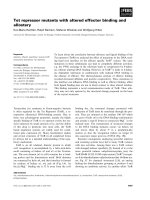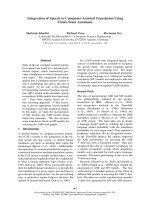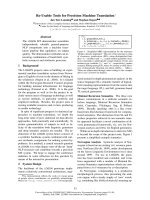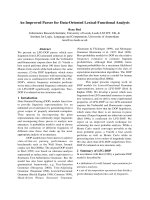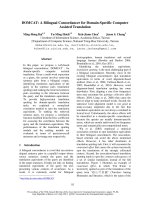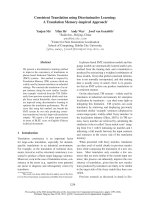Báo cáo khoa học: "Subsentential Translation Memory for Computer Assisted Writing and Translation" doc
Bạn đang xem bản rút gọn của tài liệu. Xem và tải ngay bản đầy đủ của tài liệu tại đây (54.43 KB, 4 trang )
Subsentential Translation Memory for
Computer Assisted Writing and Translation
Jian-Cheng Wu
Department of Computer Science
National Tsing Hua University
101, Kuangfu Road, Hsinchu, 300,
Taiwan, ROC
Thomas C. Chuang
Department of Computer Science
Van Nung Institute of Technology
No. 1 Van-Nung Road
Chung-Li Tao-Yuan, Taiwan, ROC
Wen-Chi Shei , Jason S. Chang
Department of Computer Science
National Tsing Hua University
101, Kuangfu Road, Hsinchu, 300,
Taiwan, ROC
Abstract
This paper describes a database of translation
memory, TotalRecall, developed to encourage
authentic and idiomatic use in second
language writing. TotalRecall is a bilingual
concordancer that support search query in
English or Chinese for relevant sentences and
translations. Although initially intended for
learners of English as Foreign Language (EFL)
in Taiwan, it is a gold mine of texts in English
or Mandarin Chinese. TotalRecall is
particularly useful for those who write in or
translate into a foreign language. We exploited
and structured existing high-quality
translations from bilingual corpora from a
Taiwan-based Sinorama Magazine and
Official Records of Hong Kong Legislative
Council to build a bilingual concordance.
Novel approaches were taken to provide high-
precision bilingual alignment on the
subsentential and lexical levels. A browser-
based user interface was developed for ease of
access over the Internet. Users can search for
word, phrase or expression in English or
Mandarin. The Web-based user interface
facilitates the recording of the user actions to
provide data for further research.
1 Introduction
Translation memory has been found to be more
effective alternative to machine translation for
translators, especially when working with batches
of similar texts. That is particularly true with so-
called delta translation of the next versions for
publications that need continuous revision such as
an encyclopaedia or user’s manual. On another
area of language study, researchers on English
Language Teaching (ELT) have increasingly
looked to concordancer of very large corpora as a
new re-source for translation and language learning.
Concordancers have been indispensable for
lexicographers. But now language teachers and
students also embrace the concordancer to foster
data-driven, student-centered learning.
A bilingual concordance, in a way, meets the
needs of both communities, the computer assisted
translation (CAT) and computer assisted language
learning (CALL). A bilingual concordancer is like
a monolingual concordance, except that each
sentence is followed by its translation counterpart
in a second language. “Existing translations
contain more solutions to more translation
problems than any other existing resource.”
(Isabelle 1993). The same can be argued for
language learning; existing texts offer more
answers for the learner than any teacher or
reference work do.
However, it is important to provide easy access
for translators and learning writers alike to find the
relevant and informative citations quickly. For in-
stance, the English-French concordance system,
TransSearch provides a familiar interface for the
users (Macklovitch et al. 2000). The user type in
the expression in question, a list of citations will
come up and it is easy to scroll down until one
finds translation that is useful much like using a
search engine. TransSearch exploits sentence
alignment techniques (Brown et al 1990; Gale and
Church 1990) to facilitate bilingual search at the
granularity level of sentences.
In this paper, we describe a bilingual
concordancer which facilitate search and
visualization with fine granularity. TotalRecall
exploits subsentential and word alignment to
provide a new kind of bilingual concordancer.
Through the interactive interface and clustering of
short subsentential bi-lingual citations, it helps
translators and non-native speakers find ways to
translate or express them-selves in a foreign
language.
2 Aligning the corpus
Central to TotalRecall is a bilingual corpus and a
set of programs that provide the bilingual analyses
to yield a translation memory database out of the
bilingual corpus. Currently, we are working with
A: Database selection B: English query C: Chinese query D: Number of items per page
E: Normal view F: Clustered summary according to translation G: Order by counts or lengths
H: Submit bottom I: Help file J: Page index K: English citation L: Chinese citation M: Date and title
N: All citations in the cluster O: Full text context P: Side-by-side sentence alignment
Figure 2. The results of searching for “hard”
bilingual corpora from a Taiwan-based Sinorama
Magazine and Official Records of Hong Kong
Legislative Council. A large bilingual collection of
Studio Classroom English lessons will be provided
in the near future. That would allow us to offer
bilingual texts in both translation directions and
with different levels of difficulty. Currently, the
articles from Sinorama seems to be quite usefully
by its own, covering a wide range of topics,
reflecting the personalities, places, and events in
Taiwan for the past three decades.
The concordance database is composed of bi-
lingual sentence pairs, which are mutual translation.
In addition, there are also tables to record
additional information, including the source of
each sentence pairs, metadata, and the information
on phrase and word level alignment. With that
additional information, TotalRecall provides
various functions, including 1. viewing of the full
text of the source with a simple click. 2.
highlighted translation counterpart of the query
word or phrase. 3. ranking that is pedagogically
useful for translation and language learning.
We are currently running an operational system
with Sinorama Magazine articles and HK LEGCO
records. These bilingual texts that go into
TotalRecall must be rearranged and structured. We
describe the main steps below:
2.1 Subsentential alignment
While the length-based approach (Church and
Gale 1991) to sentence alignment produces very
good results for close language pairs such as
French and English at success rates well over 96%,
it does not fair as well for disparate language pairs
such as English and Mandarin Chinese. Also
sentence alignment tends to produce pairs of a long
Chinese sentence and several English sentences.
Such pairs of mutual translation make it difficult
for the user to read and grasp the answers
embedded in the retrieved citations.
We develop a new approach to aligning English
and Mandarin texts at sub-sentential level in
parallel corpora based on length and punctuation
marks.
The subsentential alignment starts with parsing
each article from corpora and putting them into the
database. Subsequently articles are segmented into
subsentential segments. Finally, segments in the
two languages which are mutual translation are
aligned.
Sentences and subsentenial phrases and clauses
are broken up by various types of punctuation in
the two languages. For fragments much shorter
than sentences, the variances of length ratio are
larger leading to unacceptably low precision rate
for alignment. We combine length-based and
punctuation-based approach to cope with the
difficulties in subsentential alignment.
Punctuations in one language translate more or less
consistently into punctuations in the other language.
Therefore the information is useful in
compensating for the weakness of length-based
approach. In addition, we seek to further improve
the accuracy rates by employing cognates and
lexical information. We experimented with an
implementation of the pro-posed method on a very
large Mandarin-English parallel corpus of records
of Hong Kong Legislative Council with
satisfactory results. Experiment results show that
the punctuation-based approach outperforms the
length-based approach with precision rates
approaching 98%.
Figure 1 The result of subsentential alignment
and collocation alignment.
2.2 Word and Collocation Alignment
After sentences and their translation counterparts
are identified, we proceeded to carry out finer-
grained alignment on the word level. We employed
the Competitive Linking Algorithm (Melamed
2000) produce high precision word alignment. We
also extract English collocations and their transla-
tion equivalent based on the result of word align-
ment. These alignment results were subsequently
used to cluster citations and highlight translation
equivalents of the query.
3 Aligning the corpus
TotalRecall allows a user to look for instances of
specific words or expressions and its translation
counterpart. For this purpose, the system opens up
two text boxes for the user to enter queries in any
or both of the two languages involved. We offer
some special expressions for users to specify the
following queries:
• Single or multi-word query – spaces be-
tween words in a query are considered as “and.”
For disjunctive query, use “||” to de-note “or.”
• Every word in the query will be expanded
to all surface forms for search. That includes
singular and plural forms, and various tense of the
verbs.
• TotalRecall automatically ignore high fre-
quency words in a stoplist such as “the,” “to,” and
“of.”
• It is also possible to ask for exact match by
submitting query in quotes. Any word within the
quotes will not be ignored. It is useful for
searching named entities.
Once a query is submitted, TotalRecall displays
the results on Web pages. Each result appears as a
pair of segments in English and Chinese, in side-
by-side format. A “context” hypertext link is in-
cluded for each citation. If this link is selected, a
new page appears displaying the original document
of the pair. If the user so wishes, she can scroll
through the following or preceding pages of con-
text in the original document. TotalRecall present
the results in a way that makes it easy for the user
to grasp the information returned to her:
• When operating in the monolingual mode,
TotalRecall presents the citation according to
lengths.
• When operating in the bilingual mode, To-
talRecall clusters the citations according to the
translation counterparts and presents the user with
a summary page of one example each for different
translations. The query words and translation
counterparts are high-lighted.
4 Conclusion
In this paper, we describe a bilingual
concordance designed as a computer assisted
translation and language learning tool. Currently,
TotalRecll uses Sinorama Magazine and
HKLEGCO corpora as the databases of translation
memory. We have already put a beta version on
line and experimented with a focus group of
second language learners. Novel features of
TotalRecall include highlighting of query and
corresponding translations, clustering and ranking
of search results according translation and
frequency.
TotalRecall enable the non-native speaker who is
looking for a way to express an idea in English or
Mandarin. We are also adding on the basic func-
tions to include a log of user activities, which will
record the users’ query behavior and their back-
ground. We could then analyze the data and find
useful information for future research.
Subsentential alignment results
From 1983 to 1991, the average rate of wage growth for all trades
and industries was only 1.6%.
八三至九一年全部行業的平均工資增長率僅得 1.6%,
This was far lower than the growth in labour productivity, which
averaged 5.3%.
遠較勞動生產力平均增長率的 5.3%為低,
But, it must also be noted that the average inflation rate was as
high as 7.7% during the same period.
但同期的平均通脹率卻高達 7.7%,
As I have said before, even when the economy is booming, the
workers are unable to share the fruit of economic success.
正如我之前所說,縱使經濟前景良好,勞工也無從分享經濟
成果。
Acknowledgement
We acknowledge the support for this study
through grants from National Science Council and
Ministry of Education, Taiwan (NSC 91-2213-E-
007-061 and MOE EX-92-E-FA06-4-4) and a
special grant for preparing the Sinorama Corpus
for distri-bution by the Association for
Computational Lin-guistics and Chinese Language
Processing.
References
Brown P., Cocke J., Della Pietra S., Jelinek F.,
Lafferty J., Mercer R., & Roossin P. (1990). A
statistical approach to machine translation.
Computational Linguistics, vol. 16.
Gale, W. & K. W. Church, "A Program for
Aligning Sen-tences in Bilingual Corpora"
Proceedings of the 29th An-nual Meeting of the
Association for Computational Linguistics,
Berkeley, CA, 1991.
Isabelle, Pierre, M. Dymetman, G. Foster, J-M.
Jutras, E. Macklovitch, F. Perrault, X. Ren and
M. Simard. 1993. Translation Analysis and
Translation Automation. In Pro-ceedings of the
Fifth International Conference on Theoreti-cal
and Methodological Issues in Machine
Translation, Kyoto, Japan, pp. 12-20.
I. Dan Melamed. 2000. Models of translational
equivalence among words. Computational
Linguistics, 26(2):221–249, June.
